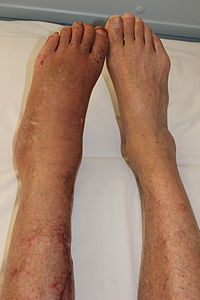
Photo from wikipedia
The acute phase of complex regional pain syndrome (CRPS) is pathophysiologically characterized by an activation of the immune system and its associated inflammatory response. During the course of CRPS, central… Click to show full abstract
The acute phase of complex regional pain syndrome (CRPS) is pathophysiologically characterized by an activation of the immune system and its associated inflammatory response. During the course of CRPS, central nervous symptoms like mechanical hyperalgesia, loss of sensation, and body perception disorders develop. Psychological factors such as pain-related anxiety and traumatic events might have a negative effect on the treatment outcome. While the visible inflammatory symptoms improve, the pain often persists. A stage adapted, targeted treatment could improve the prognosis. Effective multidisciplinary treatment includes the following: pharmacotherapy with steroids, bisphosphonates, or dimethylsulfoxide cream (acute phase), and antineuropathic analgesics (all phases); physiotherapy and behavioral therapy for pain-related anxiety and avoidance of movement; and interventional treatment like spinal cord or dorsal root ganglion stimulation if noninvasive options failed.
Journal Title: Schmerz
Year Published: 2018
Link to full text (if available)
Share on Social Media: Sign Up to like & get
recommendations!